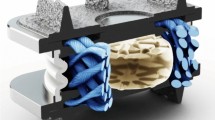Abstract
Purpose
To determine whether preliminary evidence supports X-STOP implants as an effective treatment for lumbar radiculopathy secondary to foraminal stenosis, and if larger formal trials are warranted.
Methods
Participants had a clinical diagnosis of lumbar radiculopathy supported by MRI findings of foraminal stenosis and relevant nerve root compression. Self-reported disability and pain were measured pre-operation, early and late post-operation using the widely used Oswestry Disablity Index (ODI) and the bodily pain scale of the Medical Outcomes Study 36-item Short Form Health Survey (SF-36BP). The statistical significance (paired samples t test; Wilcoxon signed ranks test), and clinical significance (Cohen’s effect size; Standardised response means) of change scores was determined.
Results
Fifteen people had X-STOP implants. Data pre- early- and late post-operation were available for ten. Self-reported disability and pain improved substantially by the early post operative measurement. Mean change scores (ODI = 29; SF-36BP = −45), significant at the p < 0.05 but not significant at the p < 0.001, were very large and effect sizes exceeded notably criteria for large clinical improvements (>0.80). Improvements were maintained at 2–3 years. Both scales had floor and ceiling effects implying changes may be underestimated. There were no surgical complications.
Conclusions
In this small study, X-STOP appeared safe and effective. It is less invasive than other established surgical procedures, but does not jeopardise other options in the event of failure. Large scale clinical trials are justified but floor and ceiling effects suggest that the ODI and SF-36 may not be the best choice of outcome measures for those studies.


Similar content being viewed by others
References
Gibson JN, Waddell G (2007) Surgical interventions for lumbar disc prolapse: updated Cochrane Review. Spine 32(16):1735–1747
Weinstein J, Tosteson T, Lurie J et al (2006) Surgical vs nonoperative treatment for lumbar disk herniation. JAMA 296(20):2441–2450
Weinstein J, Tosteson T, Lurie J et al (2008) Surgical versus nonsurgical therapy for lumbar spinal stenosis. N Engl J Med 358:794–810
Weinstein J, Lurie J, Tosteson T et al (2007) Surgical versus nonsurgical treatment for lumbar degenerative spondylolisthesis. N Engl J Med 356:2239–2243
Zucherman JF et al (2004) A Prospective randomised multicentre study for the treatment of lumbar spinal stenosis with the X-STOP interspinous implant: 1 year results. Eur Spine J 13:22–31
Fairbank J, Frost H, Wilson-MacDonald J et al (2005) Randomised controlled trial to compare surgical stabilisation of the lumbar spine with an intensive rehabilitation programme for patients with chronic low back pain: the MRC spine stabilisation trial. BMJ 330:1233–1239
Fairbank J, Pynsent PB (2000) The oswestry disability index. Spine 25(22):2940–2953
Ware JE Jr, Snow KK, Kosinski M, Gandek B (1993) The SF-36 health survey manual and interpretation guide. Nimrod Press, Boston MA
Baron RA, Elashaal A, Germon TJ, Hobart JC (2006) Measuring outcomes in cervical spine surgery: think twice before using the SF-36. Spine 31(22):2575–2584
Cohen J (1969) Statistical power analysis for the behavioural sciences. Academic Press, New York
Kazis LE, Anderson JJ, Meenan RF (1989) Effect sizes for interpreting changes in health status. Med Care 27(3 suppl):S178–S189
Verhoof OJ, Bron JL, Wapstra FH, van Royen BJ (2008) High failure rate of the interspinous distraction device (X-STOP) for the treatment of lumbar spinal stenosis caused by degenerative spondylolisthesis. Eur Spine J 17:188–192
Brussee P, Hauth J, Donk RD, Verbeek AL, Bartels RH (2008) Self-red evaluation of outcome of the implantation of interspinous process distraction (X-STOP) for neurogenic claudication. Eur Spine J 17(2):200–203
Barbagallo GM, Olindo G, Corbino L, Albanese V (2009) Analysis of complication in patients treated with the X-STOP interspinous process decompression system: proposal for a novel anatomic scoring system for patient selection and review of the literature. Neurosurgery 65(1):111–112
Bowers C, Amini A, Dailey AT, Schmidt MH (2008) Dynamic interspinous process stabilisation: review of complications associated with the XSTOP device. Neurosurg Focus 28(6):E8
Hallett A, Huntley JS, Gibson JNA (2007) Foraminal stenosis and single-level degenerative disc disease. Spine 32(13):1375–1380
Hejazi N, Wizmann A, Hergan K, Hassler W (2002) Combined transarticular lateral and medial approach with partial facetectomy for lumbar foraminal stenosis. J Neurosurg (Spine) 96:118–121
Shenouda EF, Gill SS (2002) Laminal fenestration for the treatment of lumbar nerve root foraminal stenosis. Brit J Neurosurg 16(5):494–497
Osman SG, Nibu K, Panjabi MM, Marsolais EB, Chaudhary R (1997) Transforaminal and posterior decompressions of the lumbar spine. A comparative study of stability and intervertebral foramen area. Spine 22(15):1690–1695
Ahn Y, Lee SH, Park WM, Lee HY (2003) Postero-lateral percutaneous endoscopic lumbar foraminotomy for L5–S1 foraminal or lateral exit zone stenosis technical note. J Neuorsurg 99(3 suppl):320–323
Nellensteijn J, Ostelo R, Bartels R et al (2010) Transforaminal endoscopic surgery for lumbar stenosis: a systematic review. Eur Spine J 19(6):879–886
Siddiqui M, Nicol M, Kradimas E, Smith F, Wardlaw D (2005) The positional magnetic resonance imaging changes in the lumbar spine following insertion of a novel interspinous process distraction device. Spine 30(23):2677–2682
Conflict of interest
None.
Author information
Authors and Affiliations
Corresponding author
Rights and permissions
About this article
Cite this article
Hobart, J., Gilkes, C., Adams, W. et al. Interspinous spacers for lumbar foraminal stenosis: formal trials are justified. Eur Spine J 22 (Suppl 1), 47–53 (2013). https://doi.org/10.1007/s00586-012-2650-z
Received:
Revised:
Accepted:
Published:
Issue Date:
DOI: https://doi.org/10.1007/s00586-012-2650-z




